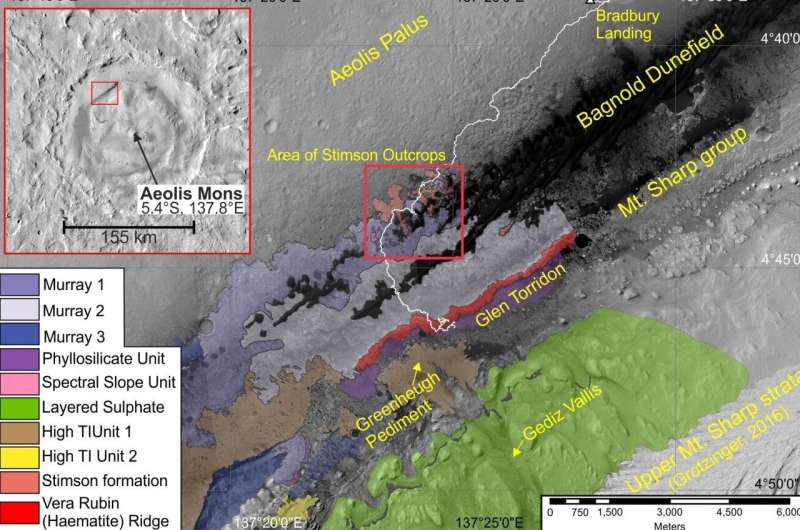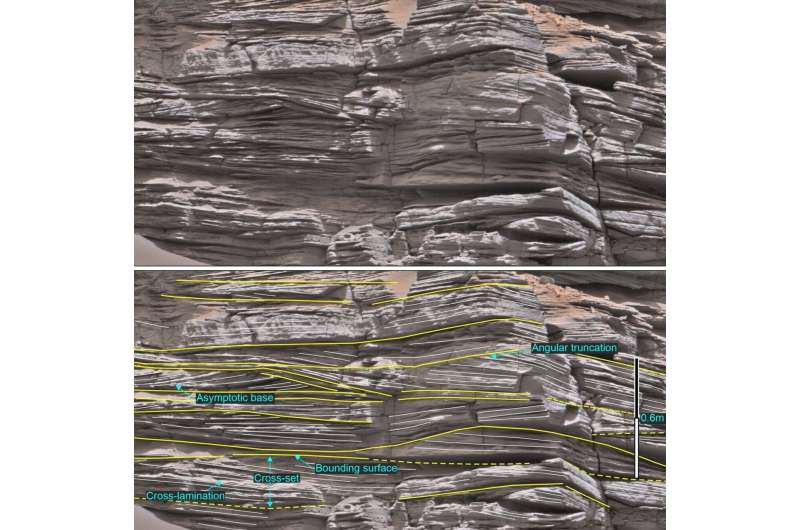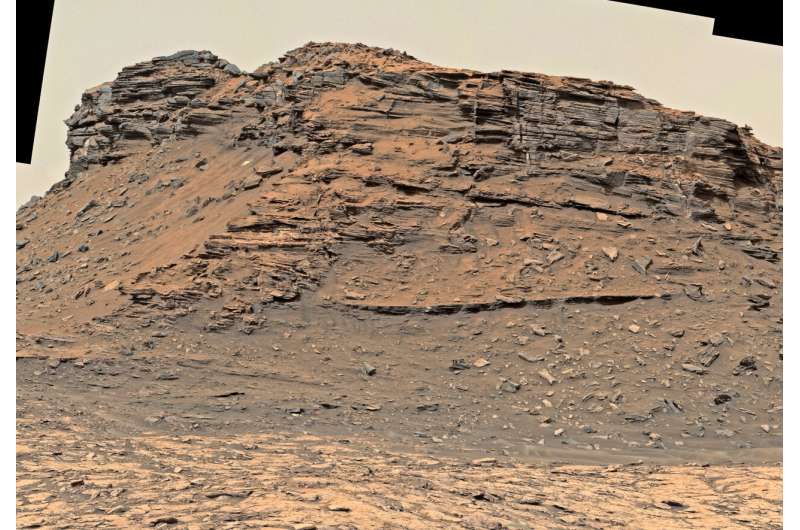By looking at the preserved rock layers through images collected by the Curiosity rover, the researchers reconstructed the shape, migration direction and size of the large dunes, also known as draas, that occupied that part of the crater.
The models of ancient dunes, created by Imperial researchers, show that dunes were nestled next to the central peak of Gale crater—known as Mount Sharp—on a wind-eroded surface at a five-degree angle. The research also found that the dunes were compound dunes—large dunes which hosted their own set of smaller dunes which traveled in a different directions to the main dune.
Lead author Dr. Steven Banham of Imperial's Department of Earth Science and Engineering said: "As the wind blows, it transports sand grains of a certain size, and organizes them into piles of sand we recognize as sand dunes. These landforms are common on Earth in sandy deserts, such as the Sahara, the Namibian dune field, and the Arabian deserts. The strength of the wind and its uniformity of direction control the shape and size of the dune, and evidence of this can be preserved in the rock record.
"If there is an excess of sediment transported into a region, dunes can climb as they migrate and partially bury adjacent dunes. These buried layers contain a feature called 'cross-bedding," which can give an indication of the size of the dunes, and the direction which they were migrating. By investigating these cross beds, we were able to determine these strata were deposited by specific dunes that form when competing winds transport sediment in two different directions.
"It's amazing that from looking at Martian rocks we can determine that two competing winds drove these large dunes across the plains of Gale crater three and a half billion years ago. This is some of the first evidence we have of variable wind directions—be they seasonal or otherwise."
The lower part of Mount Sharp is composed of ancient lakebed sediments. These sediments accumulated on the lakebed when the crater flooded, shortly after its formation 3.8 billion years ago. Curiosity has spent much of the last nine years investigating these rocks for signs of habitability.
Dr. Banham added: "More than 3.5 billion years ago this lake dried out, and the lake bottom sediments were exhumed and eroded to form the mountain at the center of the crater—the present-day Mount Sharp. The flanks of the mountain are where we have found evidence that an ancient dune field formed after the lake, indicating an extremely arid climate."

However, the new findings suggest that the ancient dune field might have been less nurturing of life than previously thought. Dr. Banham said: "The vast expanse of the dune field wouldn't have been a particularly hospitable place for microbes to live, and the record left behind would rarely preserve evidence of life, if there was any.
"This desert sand represents a snapshot of time within Gale crater, and we know that the dune field was preceded by lakes—yet we don't know what overlies the desert sandstones further up Mount Sharp. It could be more layers deposited in arid conditions, or it could be deposits associated with more humid climates. We will have to wait and see."
Rovers on Mars are allowing researchers to explore the planet in detail like never before. Dr. Banham added: "Although geologists have been reading rocks on Earth for 200 years, it's only in the last decade or so that we've been able to read Martian rocks with the same level of detail as we do on Earth."
The researchers continue to examine rocks found by Curiosity and are now focusing on the wind patterns recorded by dunes further up Mount Sharp. Dr. Banham said: "We're interested to see how the dunes reflect the wider climate of Mars, its changing seasons, and longer-term changes in wind direction. Ultimately, this all relates to the major driving question: to discover whether life ever arose on Mars."
An international team led by Imperial has found evidence of ancient dunes on Mars that could help explain ancient surface conditions.
Understanding whether Mars was once able to support life has been a major driving force for Mars research over the past 50 years. To decipher the planet's ancient climate and habitability, researchers look to the rock record—a physical record of ancient surface processes which reflect the environment and the prevailing climate at the time the rocks were deposited.
In a new paper published in JGR: Planets, researchers on the NASA-JPL Mars Science Laboratory mission used the Curiosity rover to add another piece to the puzzle of Mars' ancient past by investigating a unit of rocks within Gale crater.
They found evidence of an ancient dune field preserved as a layer of rocks in Gale crater, which overlies rock layers that were deposited in a large lake. The rock remnants of the dune field are known today as the Stimson formation.
The findings will help scientists understand surface and atmospheric processes—such as the direction the wind blew sand to form dunes—and potentially how Mars' climate evolved from an environment that potentially harbored microbial life, to an uninhabitable one.
By studying the preserved rock layers in images collected by Curiosity, the researchers reconstructed the shape, migration direction and size of the large dunes, also known as draas, that occupied that part of the crater.
The models of ancient dunes, created by Imperial researchers, show that dunes were nestled next to the central peak of Gale crater—known as Mount Sharp—on a wind-eroded surface at a five-degree angle. The research also found that the dunes were compound dunes—large dunes which hosted their own set of smaller dunes which traveled in a different directions to the main dune.

Lead author Dr. Steven Banham of Imperial's Department of Earth Science and Engineering said: "As the wind blows, it transports sand grains of a certain size, and organizes them into piles of sand we recognize as sand dunes. These landforms are common on Earth in sandy deserts, such as the Sahara, the Namibian dune field, and the Arabian deserts. The strength of the wind and its uniformity of direction control the shape and size of the dune, and evidence of this can be preserved in the rock record.
"If there is an excess of sediment transported into a region, dunes can climb as they migrate and partially bury adjacent dunes. These buried layers contain a feature called 'cross-bedding," which can give an indication of the size of the dunes, and the direction which they were migrating. By investigating these cross beds, we were able to determine these strata were deposited by specific dunes that form when competing winds transport sediment in two different directions.
"It's amazing that from looking at Martian rocks we can determine that two competing winds drove these large dunes across the plains of Gale crater three and a half billion years ago. This is some of the first evidence we have of variable wind directions—be they seasonal or otherwise."
The lower part of Mount Sharp is composed of ancient lakebed sediments. These sediments accumulated on the lakebed when the crater flooded, shortly after its formation 3.8 billion years ago. Curiosity has spent much of the last nine years investigating these rocks for signs of habitability.
Dr. Banham added: "More than 3.5 billion years ago this lake dried out, and the lake bottom sediments were exhumed and eroded to form the mountain at the center of the crater—the present-day Mount Sharp. The flanks of the mountain are where we have found evidence that an ancient dune field formed after the lake, indicating an extremely arid climate."
Inhospitable environment?
However, the new findings suggest that the ancient dune field might have been less nurturing of life than previously thought. Dr. Banham said: "The vast expanse of the dune field wouldn't have been a particularly hospitable place for microbes to live, and the record left behind would rarely preserve evidence of life, if there was any.
"This desert sand represents a snapshot of time within Gale crater, and we know that the dune field was preceded by lakes—yet we don't know what overlies the desert sandstones further up Mount Sharp. It could be more layers deposited in arid conditions, or it could be deposits associated with more humid climates. We will have to wait and see."
Rovers on Mars are allowing researchers to explore the planet in detail like never before. Dr. Banham said: "Although geologists have been reading rocks on Earth for 200 years, it's only in the last decade or so that we've been able to read Martian rocks with the same level of detail as we do on Earth."
The researchers continue to examine rocks found by Curiosity and are now focusing on the wind patterns recorded by dunes further up Mount Sharp. Dr. Banham said: "We're interested to see how the dunes reflect the wider climate of Mars, its changing seasons, and longer-term changes in wind direction. Ultimately, this all relates to the major driving question: to discover whether life ever arose on Mars."
The research was funded by the UK Space Agency and forms part of the preparation for the forthcoming ESA ExoMars mission to explore Mars for signs of ancient life.
"A Rock Record of Complex Aeolian Bedforms in a Hesperian Desert Landscape: The Stimson Formation as Exposed in the Murray Buttes, Gale Crater, Mars" is published in JGR: Planets.
Explore further



